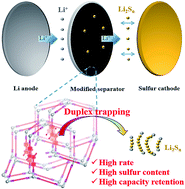Duplex trapping and charge transfer with polysulfides by a diketopyrrolopyrrole-based organic framework for high-performance lithium–sulfur batteries†
Abstract
Lithium–sulfur (Li–S) batteries are widely regarded as some of the most promising next-generation energy storage systems due to their cost advantage and high theoretical energy density. However, the shuttle effect arising from the dissolution of polysulfides into organic electrolyte, the insulating nature of sulfur and their discharge products severely restrict the development of high-energy density Li–S batteries. Herein, a porous organic framework containing diketopyrrolopyrrole (DPP) building blocks is reasonably designed and it serves as a shuttle-inhibiting layer to bifunctionally increase the physical and chemical trapping of lithium polysulfides. The frameworks were synthesized through a bottom-up approach, allowing precise control of the network design at the molecular level. As a result, the framework-derived microscale networks with polar units effectively hinder the shuttle effect of polysulfides and promise excellent electrochemical performances with regard to improving kinetics and long-term cycling stability of Li–S batteries. DFT calculations demonstrate the charge transfer (CT) behavior and favorable binding energy between the DPP units and lithium polysulfides. This work not only provides a novel strategy to fabricate a bifunctional modified separator for high-performance Li–S batteries, but also inspires us to further develop advanced materials for emerging energy storage applications.



 Please wait while we load your content...
Please wait while we load your content...